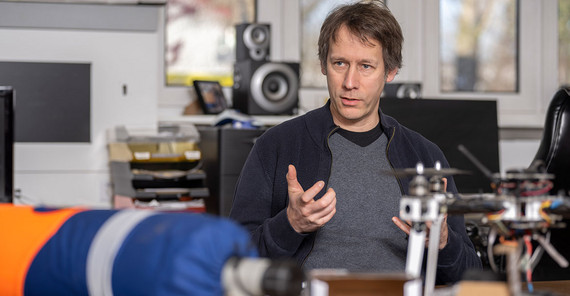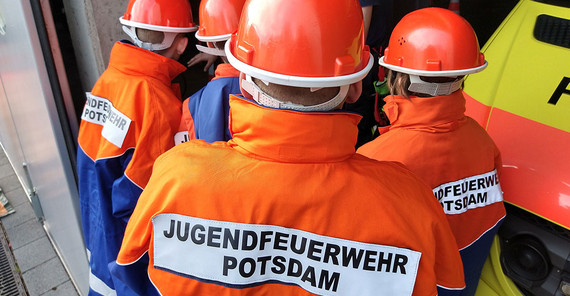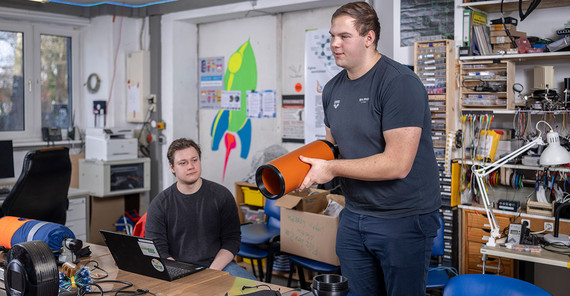It is, however, not easy for junior firefighters to learn how to handle this equipment. “The fire department’s breathing apparatuses are not approved for training with children and youths according to the German Youth Protection Act,” Eik Malte Saathoff explains. The business informatics students is a paramedic for the emergency services and is familiar with the issue. The reason for this restriction: An apparatus can weigh up to 18 kilograms and is simply too heavy.
Students Refine Blueprints
Dr. Edzard Weber, who works at the Chair of Business Informatics, likes to make use of tricky problems such as these to teach his students things beyond the lecture halls or seminar rooms. He has been working closely with a range of volunteering partners such as the Wissenschaftsladen Potsdam e.V. (an association for knowledge transfer) and youth fire departments from Potsdam and the surrounding area for around ten years. “Civil security and critical infrastructures are important topics for our chair, which is why we have been in contact with the fire department for some time,” the scientist explains. His students also benefit from this: “In smaller teams, they work on specific problems with relevance to practice, gain insights into other professions, and learn how to apply their theoretical knowledge. This is important, because business informatics specialists can later work in many different sectors: in banks or insurance companies as well as in the natural sciences or engineering.”
In 2023, the Wissenschaftsladen Potsdam, together with a youth officer from the Babelsberg-Klein Glienicke youth fire department, developed the prototype of a breathing apparatus dummy that is also suitable for children and adolescents. Eik Malte Saathoff, his fellow student Leon Oparin, and another student used this prototype as a starting point to create an improved version that can be easily replicated using a plastic tube, a computer-controlled CNC milling machine, and a 3D printer. With the help of Frieder Knabe from the Wissenschaftsladen, they spent a long time refining their construction plans. The resulting breathing apparatus dummy looks very similar to the real thing, imitates all of its features, but is nowhere near as heavy. Although such lightweight equipment is already available for purchase, it is quite expensive. The dummy optimized by the students is not only considerably cheaper at around 60 EUR, but its weight is also adjustable thanks to a hollow cylinder that can be filled. Young people can train with it just as well as those of a more advanced age.
Young Firefighters Visit the Wissenschaftsladen
After several months and numerous changes and optimizations to the blueprint, the breathing apparatus dummy was now ready for use. The students then invited young people from the Babelsberg/Klein Glienicke youth fire department to replicate the devices in the Wissenschaftsladen. The students first had to learn how to operate the milling machine and the 3D printer themselves – “with support from the Wissenschaftsladen and learning by doing,” as they put it. Finally, they developed a training course together with the youth officers to practice the correct use of the dummies in realistic scenarios and test their durability.
“Student projects like these are about gaining transfer experience and developing training concepts in order to introduce new technologies into organizations and spark people's interest,” Edzard Weber explains. “Students learn about all six phases of design-based research with the aim of discovering how things can be improved: Problem and goal analysis, design phase, tests with evaluation, communication of results and, of course, documentation of all steps.” At the same time, the partner organizations benefit from the students' work. For instance, the blueprints for the breathing apparatus dummy are now available online for free. This means that youth fire department teams will now be able to build the dummies themselves. “The association of open workshops (“Verbund offener Werkstätten”) and a number of higher education institutions have the 3D printers and CNC milling machines required for this and make them available,” Eik Malte Saathoff points out. The blueprints are already attracting a great deal of interest from volunteer fire departments and youth fire departments from other regions and federal states who want to train with the equipment.
“We had to simplify a lot of things and adapt them to the needs of future users,” says Leon Oparin, summing up his experience with the project. “It was essential for us to find the right balance between scientific methods and practical work.” Both students are now also involved in a follow-up project. They want to add an important detail to their breathing apparatus dummy and develop a pressure gauge that shows how much breathable air is left in the bottle. To do this, they are programming software to calculate exactly how much air is needed per second and when supplies would be exhausted. A warning sound beeps when the supply is running low. “This is an important add-on for realistic training scenarios,” notes Eik Malte Saathoff.
To the blueprint for the breathing apparatus dummy: https://machbar-potsdam.de/pressluftatmer-attrappen-fuer-die-jugendfeuerwehr
This article was originally published in the University Magazine Portal - Eins 2024 „Welt retten“ (PDF).



